What makes Ginataang Bilo-Bilo a favorite in Filipino homes? Its rich history and cultural importance are key. This dessert combines coconut milk, sticky rice balls, and fruits and tubers. It offers a sweet and creamy taste that Filipinos love.
Ginataang Bilo-Bilo is more than a dessert. It symbolizes Filipino hospitality and celebration. It’s often enjoyed during Christmas. Its big batch recipe is perfect for sharing with loved ones, showing the Filipino spirit of generosity.
Key Takeaways
- Ginataang Bilo-Bilo is a traditional Filipino dessert made with coconut milk, sticky rice balls, and various fruits and tubers, providing a unique dessert experience.
- This sweet treat is a staple in every Filipino household and is often served during special occasions like Christmas, making it a beloved food and dessert in the Philippines.
- Ginataang Bilo-Bilo is a symbol of Filipino hospitality and celebration, and its large batch recipe makes it perfect for sharing with family and friends, showing the Filipino spirit of generosity and community.
- The dessert is usually gluten-free and dairy-free, making it a great option for those with dietary restrictions, and its sweet and creamy flavors make it a favorite food and dessert among Filipinos.
- Ginataang Bilo-Bilo is also known as Ginataang Halo-Halo, which translates to mix-mix, reflecting the diversity of ingredients used in the recipe, and its rich history and cultural significance contribute to its enduring popularity as a food and dessert in the Philippines.
Introduction to Ginataang Bilo-Bilo
Ginataang Bilo-Bilo is a traditional Filipino dessert. It has sticky rice balls cooked in coconut milk. Various fruits and tubers add flavor and texture. It’s served warm or at room temperature, enjoyed during special occasions.
To make Ginataang Bilo-Bilo, you need a recipe with glutinous rice flour, water, coconut milk, sugar, and fruits and tubers. These ingredients are mixed and cooked to make a creamy dessert.
Here are some key ingredients and their quantities:
- 2 cups glutinous rice flour
- 1 cup water
- 2-3 cups water
- 2 400ml canned coconut milk or cream
- 1 1/2 cup cooked tapioca pearls
- 3/4 cup sugar
Ginataang Bilo-Bilo is a beloved dessert in the Philippines. Its recipe has been passed down for generations. With creamy coconut milk and sweet fruits and tubers, it’s a perfect treat for any occasion.
What is Bilo-Bilo?
Bilo-Bilo is a traditional Filipino dessert. It’s made from small glutinous balls in coconut milk and sugar. This sweet treat is a staple in Filipino cuisine, enjoyed as a snack or dessert.
The glutinous balls, also known as “bilo-bilo,” are made from glutinous rice flour and water. They have a chewy texture that goes well with the creamy coconut milk.
In Filipino food, Bilo-Bilo is a beloved dessert that brings people together. It has a rich flavor profile, with ingredients like sweet potatoes, jackfruit, and tapioca pearls. This mix of ingredients gives it a sweet and savory taste that’s unique to Filipino cuisine.

The cultural significance of Bilo-Bilo lies in its ability to bring people together. It’s often served at family gatherings and celebrations. Its rich history and varied regional recipes make it a fascinating part of Filipino culture.
As a popular Filipino food, Bilo-Bilo continues to be a staple in many households. It’s enjoyed by people of all ages.
The History of Ginataang Bilo-Bilo
Ginataang Bilo-Bilo is a traditional Filipino dessert with a long history. It comes from the Visayas region, mainly Iloilo. This sweet treat is made with glutinous rice flour, coconut milk, sugar, and salt. It’s often enjoyed as a mid-afternoon snack called merienda.
The recipe for Ginataang Bilo-Bilo has changed over time. Different fruits and tubers have been added, making it unique and delicious. Variations like binignit, tabirak, and bilo-bilo are comfort foods enjoyed during special times.
Origins in Filipino Cuisine
Ginataang Bilo-Bilo is a favorite in the Philippines, rooted in the country’s rich culture. It’s served during festivals, fiestas, and All Souls’ Day. It’s also given to the dead during these times.
Evolution Over the Years
Ginataang Bilo-Bilo has seen many changes, with new ingredients added. Yet, its sweet and creamy taste remains a hit with everyone. Here are some key ingredients and variations:
- Glutinous rice flour
- Coconut milk
- Sugar
- Salt
- Various fruits and tubers, such as saba bananas and sweet potatoes
Ginataang Bilo-Bilo showcases the Philippines’ rich culture. Its recipe keeps evolving. Whether you want a traditional Filipino dessert or a modern twist, Ginataang Bilo-Bilo is perfect.
| Ingredient | Quantity |
|---|---|
| Glutinous rice flour | 2 cups |
| Coconut milk | 1 cup |
| Sugar | 1/2 cup |
| Salt | 1/4 teaspoon |
Essential Ingredients for Bilo-Bilo
Ginataang Bilo-Bilo is a traditional Filipino dessert. It needs glutinous rice balls, coconut milk, and sweet potatoes. These ingredients make a creamy dessert great for special times.
Glutinous Rice Balls
Glutinous rice balls are key in Ginataang Bilo-Bilo. They’re made from glutinous rice flour, sugar, and water. The dough is kneaded until smooth.
Coconut Milk
Coconut milk is vital for Ginataang Bilo-Bilo. It makes the soup base creamy and rich. The coconut milk and water mix is heated until thick and creamy.
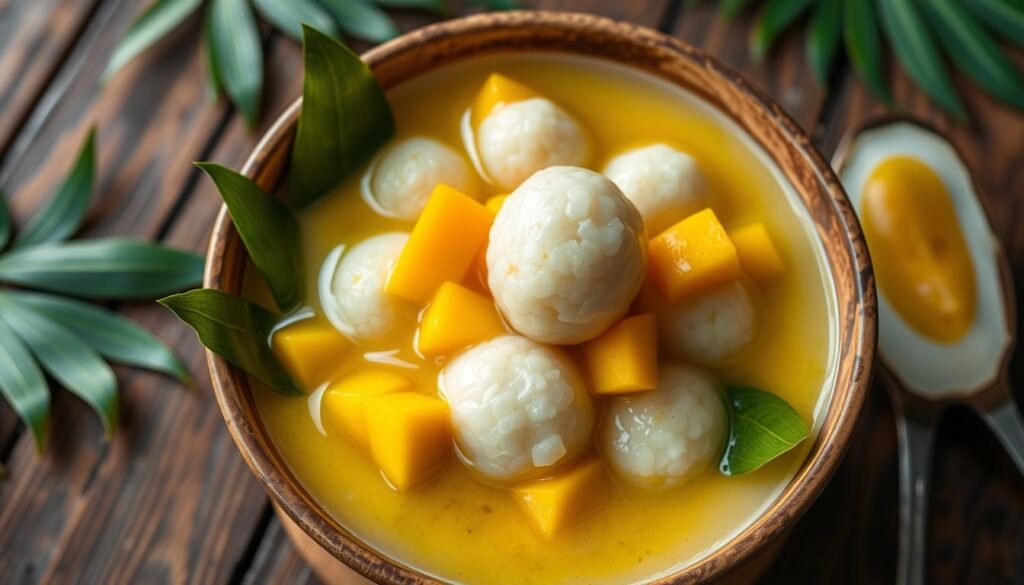
Sweet Potatoes and Other Add-ins
Sweet potatoes and add-ins like blueberries and strawberries enhance Ginataang Bilo-Bilo. Sweet potatoes are used more than other add-ins. They’re cooked until tender in the coconut milk soup.
The following table shows the proportion of key ingredients in Ginataang Bilo-Bilo:
| Ingredient | Proportion |
|---|---|
| Coconut milk | 36% |
| Glutinous rice balls | 18% |
| Cassava | 9% |
| Saba banana | 11% |
| Jackfruit | 9% |
| Other ingredients | 17% |
These ingredients make a delicious, creamy dessert. With the right mix and practice, you can make Ginataang Bilo-Bilo at home.
Step-by-Step Cooking Guide
To start, prepare the ingredients for Ginataang Bilo-Bilo. You’ll need glutinous rice balls, coconut milk, and fruits like jackfruit and Saba bananas. The recipe calls for a 4:1 ratio of coconut milk to water in the broth.
Then, make the Bilo-Bilo by mixing 1 cup of sweet glutinous rice flour with 1/2 cup of water. Shape the dough into 1-inch balls. These will cook in the broth for 5-7 minutes. Make sure to lightly dust your hands with flour to avoid sticking.

To cook the Ginataang mixture, combine coconut milk, water, and tapioca pearls. Heat it until the pearls are cooked, which takes about 10-15 minutes. You can adjust the sweetness by adding more or less brown sugar. This sweet treat is great for any occasion.
Here’s a quick guide to cooking:
- Prepare the ingredients, including glutinous rice balls and coconut milk.
- Cook the Bilo-Bilo in the broth for 5-7 minutes.
- Heat the Ginataang mixture until the tapioca pearls are cooked.
Popular Variations of Bilo-Bilo
Ginataang Bilo-Bilo is a versatile dessert loved in many ways. It’s a favorite Filipino treat that serves 8, perfect for sharing.
Regional twists include sweet potatoes, yams, and fruits. Some use coconut milk, while others prefer cow’s milk. Here are some Bilo-Bilo variations:
- Coconut milk-based Bilo-Bilo, a traditional Filipino recipe
- Fruit-based Bilo-Bilo, featuring strawberries, blueberries, and kiwi
- Rice-based Bilo-Bilo, made with glutinous rice flour
These variations show Filipino cooks’ creativity with local ingredients. Whether you want a traditional or modern dessert, Bilo-Bilo is worth trying.
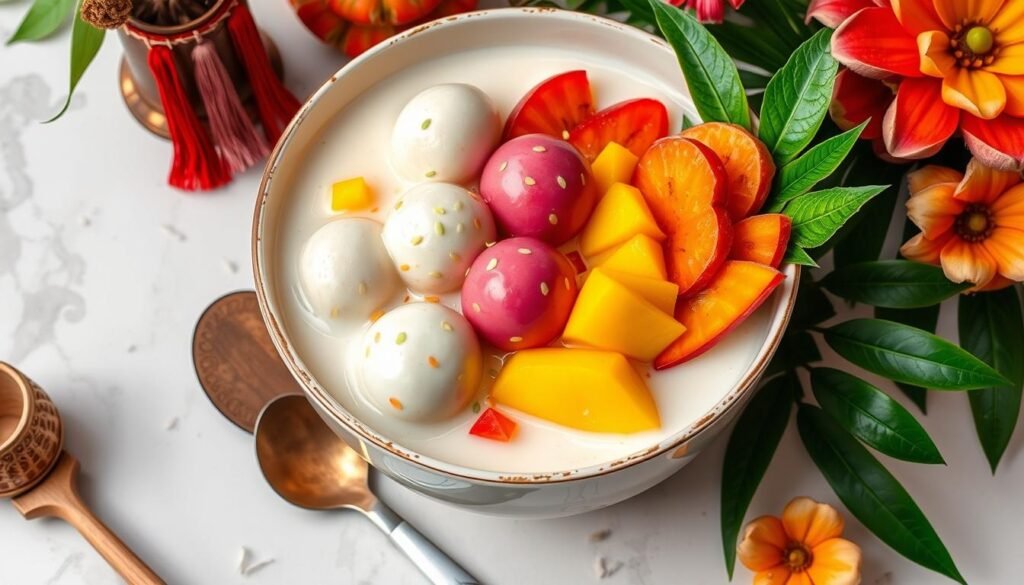
In conclusion, Ginataang Bilo-Bilo is a delicious Filipino dessert with many variations. It showcases the Philippines’ rich culinary heritage. Try making your own Bilo-Bilo today and enjoy its unique flavors.
| Ingredient | Quantity |
|---|---|
| Glutinous Rice Flour | ½ cup |
| Sugar | ¼ cup |
| Water | ¼ cup |
| Coconut Milk | 1 can (14 oz) |
Ideal Occasions for Serving Bilo-Bilo
Ginataang Bilo-Bilo is a beloved Filipino dessert for special times. It’s ideal for festive events like birthdays, weddings, and holidays. This sweet treat is a crowd-pleaser.
It’s also perfect for family get-togethers. You can make it in big batches. Serve it warm or chilled, whichever you prefer. Here are some great times to enjoy Bilo-Bilo:
- Festive celebrations, such as Christmas, New Year’s Eve, and Easter
- Family gatherings, such as reunions, picnics, and barbecues
- Special occasions, such as birthdays, weddings, and anniversaries
Ginataang Bilo-Bilo is not just tasty but also flexible. You can tailor it to fit various tastes. It’s a delightful dessert that’s both satisfying and easy to prepare.

| Occasion | Serving Suggestions |
|---|---|
| Festive celebrations | Serve warm with a sprinkle of sugar |
| Family gatherings | Serve chilled with a variety of toppings, such as fruit or nuts |
| Special occasions | Serve with a side of whipped cream or ice cream |
Nutritional Benefits of Bilo-Bilo
Ginataang Bilo-Bilo is a traditional Filipino dessert that’s both healthy and tasty. It’s made with glutinous rice balls, coconut milk, and fruits and tubers. This mix gives it lots of energy and carbs.
One serving of Bilo-Bilo has about 478.1 calories, 71.6g of carbs, and 4.5g of protein. It’s also packed with vitamins and minerals like Vitamin A, Vitamin C, calcium, and iron. Plus, it’s low in sodium, with just 62.2mg per serving.
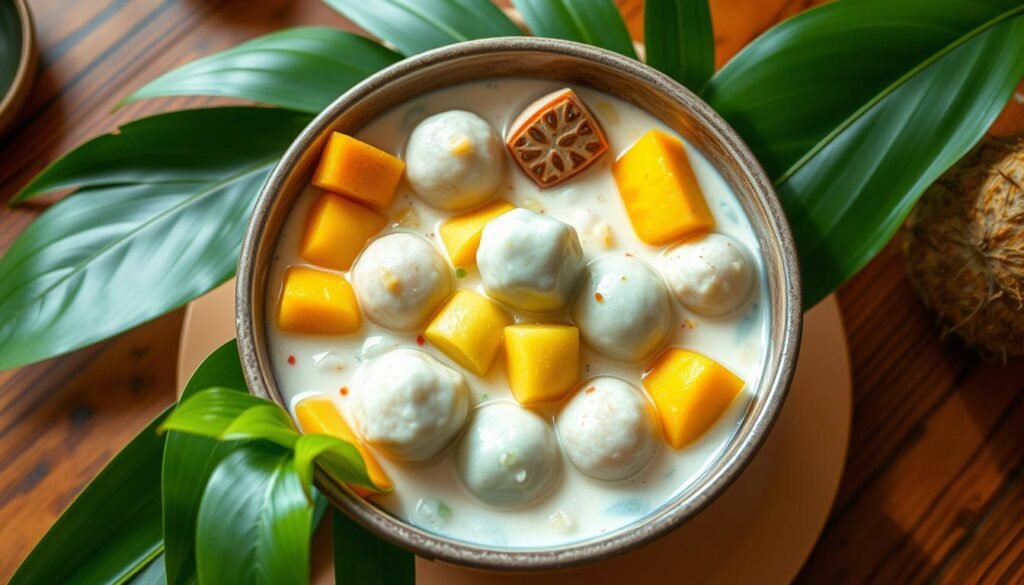
- High in fiber and protein
- Rich in vitamins and minerals
- Low in sodium
- Good source of energy and carbohydrates
Ginataang Bilo-Bilo is a tasty and healthy dessert for any diet. Its rich taste and health perks make it a favorite in the Philippines.
Pairing Bilo-Bilo with Other Filipino Dishes
Ginataang Bilo-Bilo is a versatile dessert that goes well with many Filipino food. It pairs well with other desserts and main courses. Some great options include Puto, Kutsinta, and Sapin-Sapin.
For main courses, Ginataang Bilo-Bilo works well with Adobo, Sinigang, or Lechon. The goal is to balance sweet and savory flavors. Here are some tips for pairing Ginataang Bilo-Bilo with other Filipino dishes:
- Choose dishes with complementary flavors, such as sweet and savory or spicy and sweet.
- Consider the texture of the dishes, such as pairing crunchy with soft or smooth with rough.
- Don’t be afraid to experiment and try new combinations to find your favorite pairings.
By following these tips, you can create a well-rounded meal. It will showcase the unique flavors and textures of Filipino food and dessert. Whether you’re looking for a traditional recipe or something new, Ginataang Bilo-Bilo is perfect for any occasion.
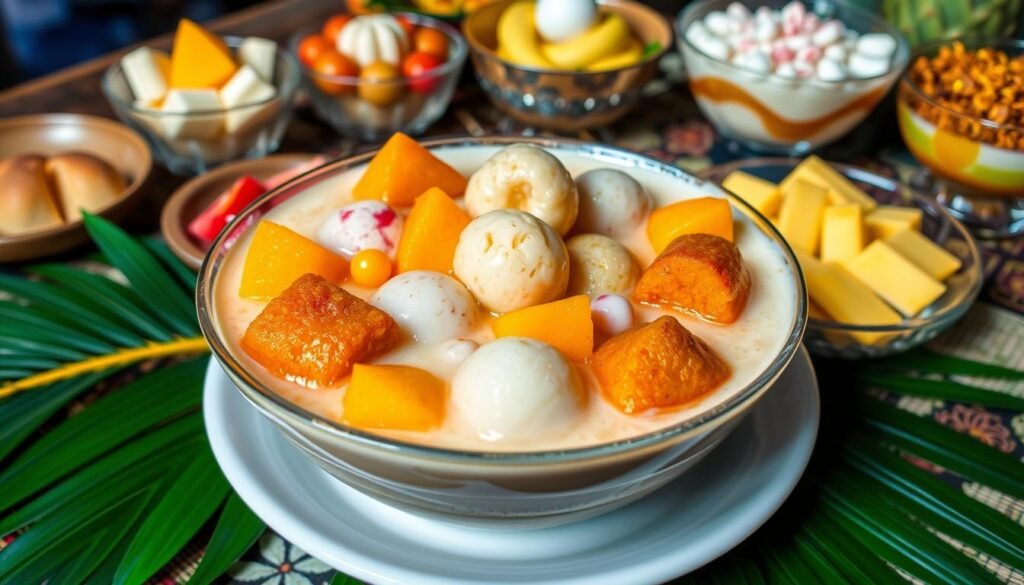
How to Store Leftover Bilo-Bilo
Storing leftover Ginataang Bilo-Bilo is easy but needs some care. To keep your dessert fresh, follow these storage tips. You can store it in a covered container in the fridge for up to three days.
Keep the food away from strong-smelling foods to avoid odors. Freezing is also an option, but it might change the texture of the glutinous rice balls. For more details, check out this website.
To reheat, place it in a saucepan with a bit of water or coconut milk. Heat it over low heat, stirring often, until it’s warm and creamy. You can also use the microwave, but be careful not to overheat it.
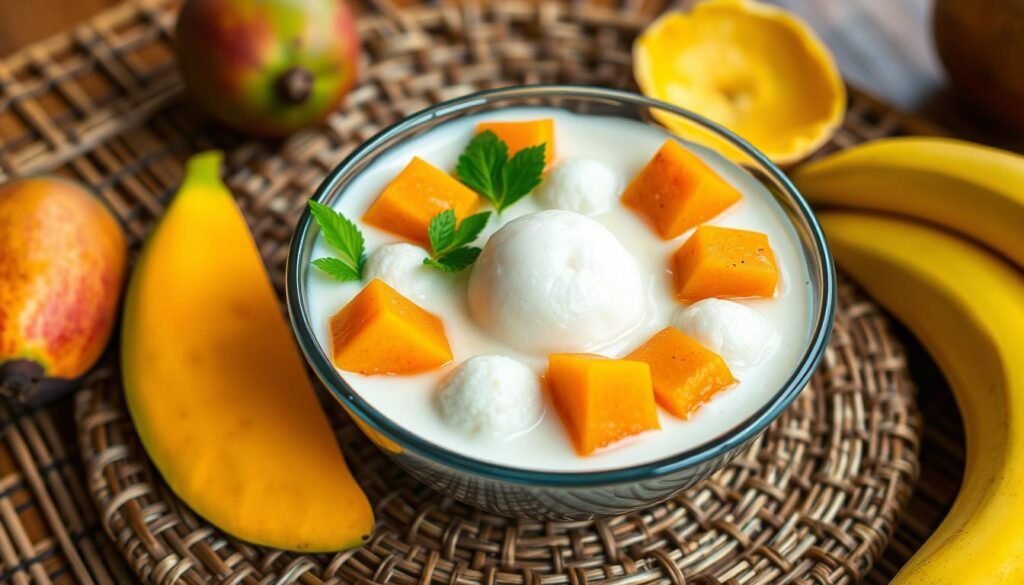
- Store it in a covered container in the refrigerator for up to three days.
- Freeze it for longer storage, but note that it may affect the texture.
- Reheat it over low heat, stirring constantly, until warm and creamy.
By following these tips, you can enjoy your leftover Bilo-Bilo for longer. And you’ll get to relish the rich taste of this traditional Filipino dessert.
Common Mistakes to Avoid in Cooking Bilo-Bilo
Cooking Ginataang Bilo-Bilo can be tricky, but with practice, you’ll get it right. To make a sweet and creamy dessert, stick to a reliable recipe and steer clear of common errors.
Here are some mistakes to watch out for:
- Using low-quality ingredients, such as old or stale coconut milk
- Not cooking the glutinous rice balls long enough, resulting in a hard or crunchy texture
- Adding too much sugar, which can make the dessert overly sweet
To get the best results, it’s key to follow a trusted recipe and prepare each ingredient with care. With time and effort, you’ll make a delicious Ginataang Bilo-Bilo that will wow your loved ones.
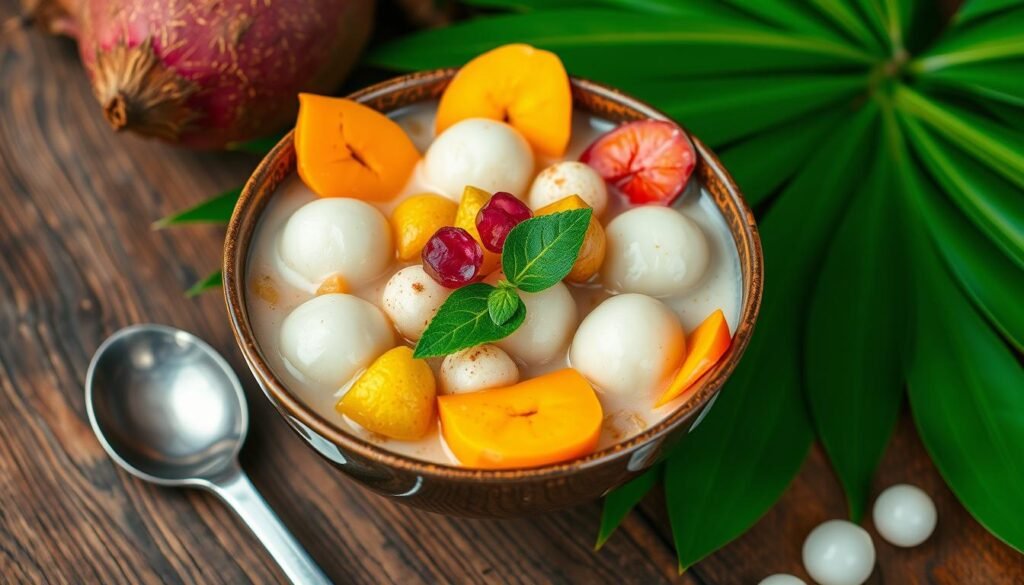
By avoiding common mistakes and sticking to a proven recipe, you’ll enjoy a tasty and sweet Ginataang Bilo-Bilo dessert. It’s perfect for any celebration.
| Ingredient | Quantity |
|---|---|
| Mochiko rice flour | 1 cup |
| Water | 1/2 cup |
| Langka (jackfruit) | 2 cups |
| Coconut milk | 2 cups |
Customer Reviews and Testimonials
Ginataang Bilo-Bilo has won the hearts of many, with a 4.8 out of 5 rating from 229 reviews. This testament to its quality shows it’s a favorite dessert. A whopping 73% of reviews gave it a perfect score.
People love its unique taste and texture. Emma Odinson says it’s a must-try for a true Filipino experience. The restaurant’s use of quality ingredients and traditional methods has made it a go-to spot. Customers like Dian Annakin and Kyle Smith keep coming back for more.
Loved by Locals
Locals adore Ginataang Bilo-Bilo, calling it a Filipino staple. Its high rating shows its popularity. Only 13% of reviews gave it a low score.
As noted on food review websites, the restaurant’s dedication to quality and tradition is unmatched. It’s known as one of the best places to try Ginataang Bilo-Bilo.
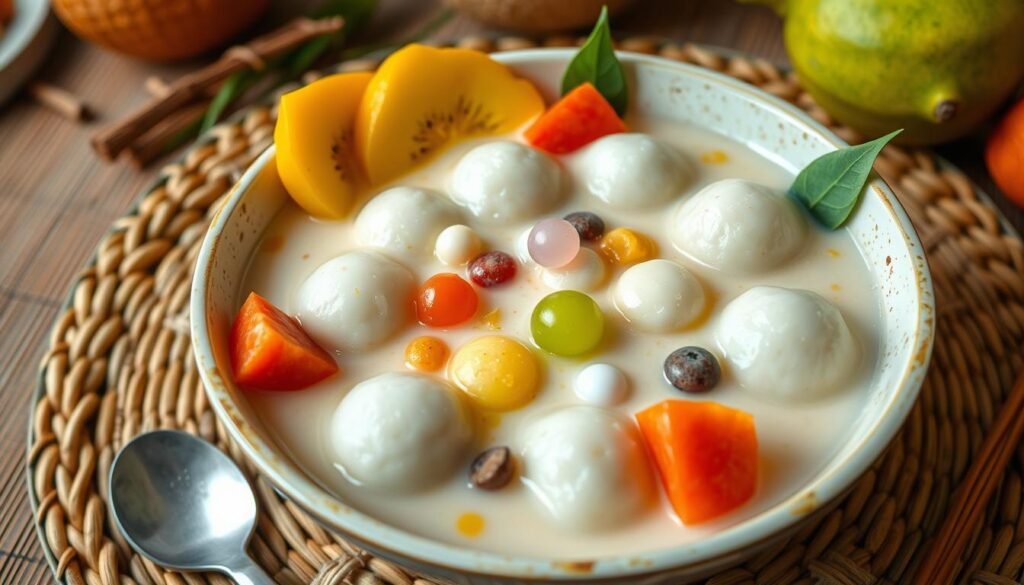
Global Appreciation
People worldwide have fallen in love with Ginataang Bilo-Bilo. Reviews rave about its unique flavor and texture. It’s considered a must-try dessert.
Here are some review statistics:
* 73% of reviews are 5-star
* 9% of reviews are 4-star
* 3% of reviews are 3-star
* 2% of reviews are 2-star
* 13% of reviews are 1-star
Conclusion: The Joy of Sharing Bilo-Bilo
Ginataang Bilo-Bilo is a traditional Filipino dessert that brings people together. It’s a sweet treat loved in Filipino celebrations. Passed down through generations, it’s a unique and delicious dessert experience.
As we wrap up our article on Ginataang Bilo-Bilo, we invite you to try it. Share it with your loved ones. For more on Filipino desserts and recipes, visit traditional Filipino sweets.
Some popular variations of Ginataang Bilo-Bilo include:
- Victorino’s Halo-Halo: Ingredients include two kinds of camote, saba, langka, bilo-bilo, chunky macapuno, leche flan, cheese, and tocino del cielo.
- Dimpy’s Halo-Halo: Components consist of gulaman, kaong, saba, langka, leche flan, and ube gelato.

Ginataang Bilo-Bilo is more than a sweet treat. It’s a symbol of Filipino hospitality and the joy of sharing desserts. So, try this recipe today and feel the warmth of Filipino culture.
Call to Action: Try Your Own Bilo-Bilo Recipe
Now that we’ve explored the rich history and mouthwatering flavors of Ginataang Bilo-Bilo, it’s time to try making it at home. Grab your apron and let’s start a culinary journey. We’ll capture the essence of this timeless treat.
With just a few simple ingredients, you can make Ginataang Bilo-Bilo. You’ll need glutinous rice balls, coconut milk, and sweet add-ins. This dish will transport your taste buds to the heart of Filipino food culture. It’s perfect for any gathering or a cozy dessert night.
So, what are you waiting for? Dive into the world of Ginataang Bilo-Bilo. Discover the joys of making this authentic recipe in your kitchen. Get ready to enjoy the sweetness, creaminess, and unforgettable flavors that make this Filipino treat a true celebration of the senses.
FAQ
What is Ginataang Bilo-Bilo?
Ginataang Bilo-Bilo is a favorite Filipino dessert. It’s made with sticky rice balls cooked in coconut milk. The mix includes fruits and tubers like sweet potatoes, bananas, and jackfruit.
What is the significance of Bilo-Bilo in this dessert?
Bilo-Bilo are the sticky rice balls in Ginataang Bilo-Bilo. They’re made from glutinous rice flour and water. Cooked in coconut milk, they make the dessert sweet and creamy.
Where does Ginataang Bilo-Bilo originate from?
Ginataang Bilo-Bilo comes from the southern Philippines. It uses coconut milk and sticky rice, common in the area. Over time, fruits and tubers were added, making it a unique treat.
What are the essential ingredients for Ginataang Bilo-Bilo?
You need glutinous rice balls, coconut milk, and fruits like sweet potatoes and bananas. These are the key ingredients.
How is Ginataang Bilo-Bilo typically served?
It’s served warm or at room temperature. People enjoy it during special occasions in the Philippines.
What are the health benefits of Ginataang Bilo-Bilo?
It’s a nutritious dessert. It gives energy and carbs, plus vitamins and minerals.
How can Ginataang Bilo-Bilo be paired with other Filipino dishes?
It pairs well with many Filipino dishes. It’s great with other desserts and main courses.
How can leftover Ginataang Bilo-Bilo be stored?
Store leftovers carefully. Follow refrigeration guidelines and reheating tips.
What are some common mistakes to avoid when cooking Ginataang Bilo-Bilo?
Avoid ingredient mistakes and cooking errors. These can ruin the dish.
How popular is Ginataang Bilo-Bilo among customers?
It’s a beloved dessert. Locals and people worldwide love it, as shown by positive reviews.
Source Links
- Ginataang Bilo Bilo – https://www.kawalingpinoy.com/ginataang-bilo-bilo/
- Classic Ginataan Bilo-Bilo (Filipino Sticky Rice Balls in Coconut Milk) | Fork & Spoon – https://itsforkandspoon.com/classic-ginataan-bilo-bilo-filipino-sticky-rice-balls-in-coconut-milk/
- Ginataang Bilo-Bilo – https://www.thelittleepicurean.com/ginataang-bilo-bilo/
- Bilo-bilo – https://en.wikipedia.org/wiki/Bilo-bilo
- Ginataang Bilo bilo (sticky rice balls in coco milk) – Foxy Folksy – https://www.foxyfolksy.com/ginataang-bilo-bilo-sticky-rice-balls-in-coco-milk/
- Ginataang Bilo bilo with Langka Recipe – https://panlasangpinoy.com/ginataang-bilo-bilo-langka-recipe/
- Ginataang Bilo-Bilo with Langka – https://sweetsimplevegan.com/ginataang-bilo-bilo-with-langka/
- Ginataan Bilo Bilo Recipe (Rice Balls, Sweet Potato & Coconut Dessert) – https://www.hungryhuy.com/ginataan-bilo-bilo/
- Filipinos Kakanin (Ginataang Bilo-bilo) A traditional food – https://steemit.com/hive-131369/@tiongson/filipinos-kakanin-ginataang-bilo-bilo-a-traditional-food
- Binignit: A fusion of history, tradition, and sacrifice in every bowl – https://www.rappler.com/philippines/mindanao/binignit-fusion-history-tradition-sacrifice/
- Ginataang Bilo Bilo with Fruit Confetti – https://rezelkealoha.com/ginataang-bilo-bilo-with-fruit-confetti/
- Easiest Bilo-Bilo – Simply Bakings – https://simplybakings.com/bilo-bilo-recipe/
- how to make bilo bilo recipe – https://www.niceys.ca/post/how-to-make-bilo-bilo-recipe
- Ginataang Bilo-Bilo: Filipino Coconut Tapioca Pudding – https://kitchenconfidante.com/ginataang-bilo-bilo-recipe
- Ginataang Bilo bilo (Chewy Rice Balls in Coconut Milk) – Astig Vegan – https://www.astigvegan.com/ginataang-bilo-bilo/
- Ginataang Bilo-Bilo – The Peach Kitchen – https://www.thepeachkitchen.com/2023/08/ginataang-bilo-bilo-2/
- How to make Stuffed Bilo-bilo | Glutinous Dessert with a Twist – https://www.bitesized.ph/recipes/stuffed-bilo-bilo/
- Healthy Ginataang Bilo-bilo – PinoyBites – https://pinoybites.com/recipes/healthy-ginataang-bilo-bilo/
- Filipino Desserts: 25 Sweets You Need to Try | Will Fly for Food – https://www.willflyforfood.net/filipino-desserts/
- Guide to Merienda in the Philippines: Best Classic Filipino Snacks | Guide to the Philippines – https://guidetothephilippines.ph/articles/ultimate-guides/merienda-snacks-philippines-guide
- Merienda – AMCARMEN’S KITCHEN – https://amcarmenskitchen.com/tag/merienda/
- Ginataang Bilo-Bilo Recipe – https://www.recipesbynora.com/ginataang-bilo-bilo/
- Ginataang Bilo-Bilo -Sweet Rice Dumplings in Coconut Milk – https://thequirinokitchen.com/how-to-make-ginataang-bilo-bilo-glutinous-rice-balls-in-coconut-milk/
- Binignit – https://www.kawalingpinoy.com/binignit/
- Ginataang Bilo Bilo Recipe – https://pilipinasrecipes.com/ginataang-bilo-bilo-recipe/
- Billo is rated "Average" with 3.7 / 5 on Trustpilot – https://www.trustpilot.com/review/billo.app
- Testimonial – Fiesta Filipina Cuisine – https://fiestafilipinalv.com/testimonial/
- Keeping your cool with halo-halo – BusinessWorld Online – https://www.bworldonline.com/arts-and-leisure/2024/04/25/590616/keeping-your-cool-with-halo-halo/
- PDF – https://journals.upd.edu.ph/index.php/lik/article/download/9363/8279/
- Pinoy Food – Page 2 – AMCARMEN’S KITCHEN – https://amcarmenskitchen.com/tag/pinoy-food/page/2/
- FILIPINO RECIPES – Have you eaten? – https://crustybread.wordpress.com/category/filipino-recipes/

